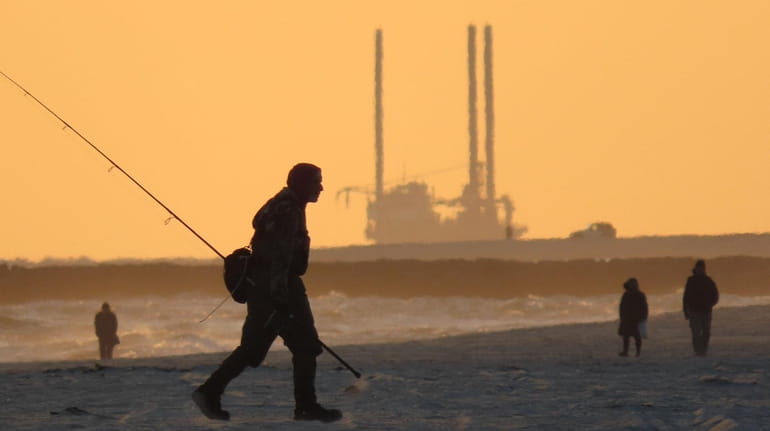Wind farm developers to install fish-tracking devices off Smith Point

A self-elevating barge off Smith Point, as seen from Moriches Inlet, conducts seafloor survey work for the Sunrise Wind Farm on Nov. 29, 2020. Credit: Mark Harrington
Developers of the Sunrise Wind Farm plan to install dozens of fish-monitoring devices in the waters off Smith Point and Eastern Long Island to study impacts of the landing cable on fish movement and health, according to newly released maps and documents.
The monitoring devices, if similar to those already installed in the waters off East Hampton for the South Fork Wind Farm, would consist of large concrete blocks dropped onto the sea floor, from which acoustic monitoring devices attached to buoys float to a point below the surface. Last year, Newsday reported that a commercial fisherman pulled one up in a trawl net, damaging a net and his boat.
One of several maps shown to Newsday show four rows of five monitoring devices each in ocean waters due south of Pattersquash Creek in Mastic, well west of Moriches inlet, and about a mile from the Fire Island shore. A Sunrise Wind spokeswoman didn’t immediately respond to a request for comment about the plan.
A presentation planned for the Rhode Island Coast Resources Management Council last week shows the wind-lease area off the coast of Rhode Island/Massachusetts with up to 102 wind turbines and a cable stretching for more than 100 miles to make landfall at Smith Point. The 924-megawatt project, which the presentation said could be up to 1,122 megawatts, will feed into the Long Island grid in Holbrook when complete in 2025. It boasts capacity enough to power up to 600,000 homes, or about half of the Long Island Power Authority's 1.1-million customer base.
The fish surveys are designed to "determine whether the construction and operational activities associated with the project lead to a change in the relative abundance of fish and invertebrates within the project area," Sunrise Wind's presentation said.
"Stakeholders have expressed concern that electromagnetic fields from power transmission cables will affect animals’ behavior or act as a barrier to migration," the presentation said, adding that the developer will work with Stony Brook University, Cornell Cooperative Extension and the Shark Research Education Program at the South Fork Natural History Museum to do the study.
Meghan Lapp, general manager of Sea Freeze Shoreside, a fish producer and trader based in Rhode Island, said the company was informed of the monitoring program on Thursday, the day of the planned conference. She wrote to a state fisheries official noting the group has "major" problems with the monitoring plan because some of the arrays are "right in the middle of squid tows off Long Island that some of our vessels were fishing."
"Orsted and Stony Brook [University] cannot simply throw 500-pound concrete blocks smack in the middle of squid tows in both New York state and federal waters without the input of affected permit holders," she wrote to James Boyd, deputy director of the Rhode Island Coastal Resources Management Council.
Bonnie Brady, executive director of the Long Island Commercial Fishing Association, based in Montauk, said she received the maps Thursday and urged the developer and its partners to send them out to all state holders of commercial food-fish licenses. "In a correct world, every food-fish [license] holder should get a copy of these maps to see if they fish in these areas," she said. It’s also an area widely fished by recreational fishing boats.
Around 125 fish a year will be tagged with special transmitters (equipped with a 2,400-day battery) to monitor their movements through and around the devices. Two different maps showed the number of monitoring devices on the sea floor to be from 20 to 28, with two separate receiver arrays along the cable route.
There will be a separate monitoring approach for scallops, which the presentation noted are a "valuable fishery in Sunrise Wind."
"This species has been identified as a priority for monitoring, and has been classified as an ‘indicator species to assess the impacts of offshore wind development,'" according to the Sunrise Wind presentation.
Part of the work will include quarterly trawl surveys of 15 trips each, to study fish size and weight and diet analysis.
Human remains search expands ... Trump hush money trial ... Year-round tick problem ... FeedMe: Pizzeria Undici
Human remains search expands ... Trump hush money trial ... Year-round tick problem ... FeedMe: Pizzeria Undici

